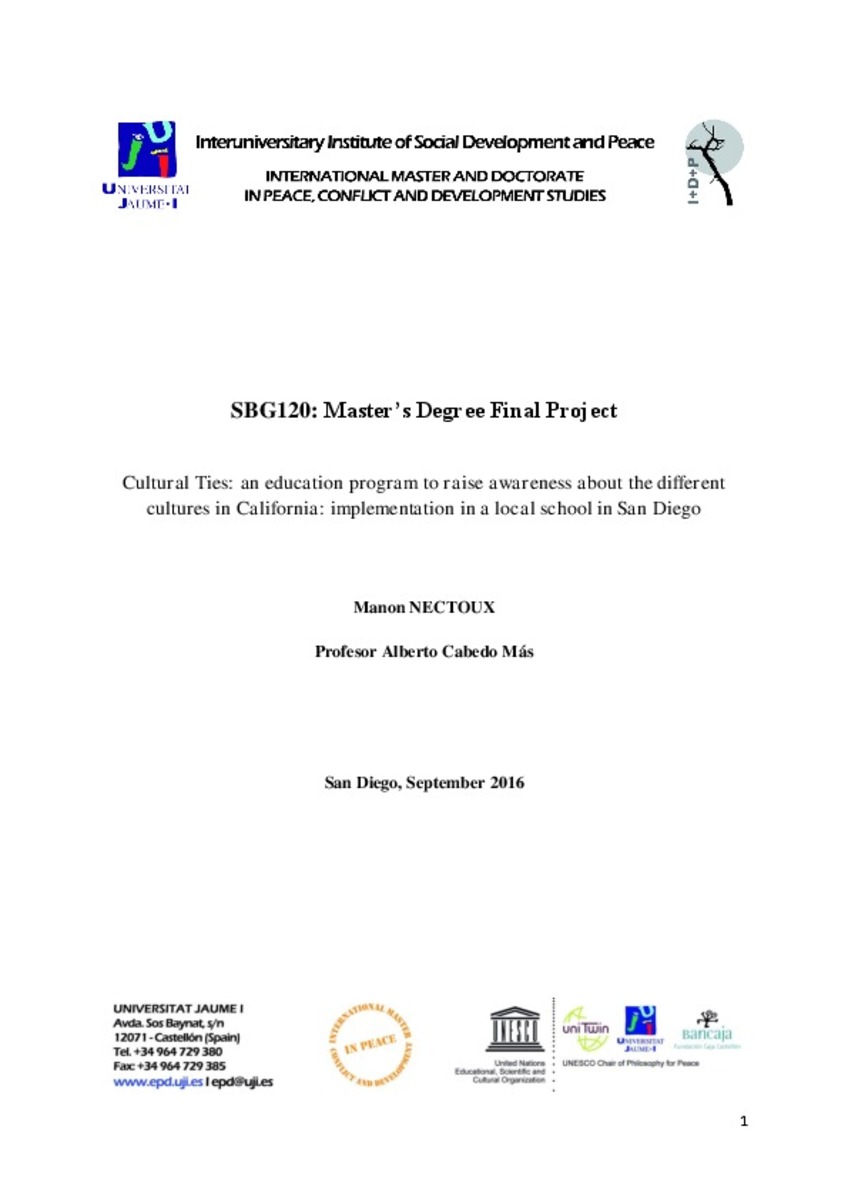Mostrar el registro sencillo del ítem
Cultural Ties : an education program to raise awareness about the different cultures in California : implementation in a local school in San Diego
| dc.contributor | Cabedo Mas, Alberto | |
| dc.contributor.author | Nectoux, Manon | |
| dc.contributor.other | Universitat Jaume I. Departament d'Educació | |
| dc.date.accessioned | 2016-11-08T16:24:32Z | |
| dc.date.available | 2016-11-08T16:24:32Z | |
| dc.date.issued | 2016-09-22 | |
| dc.identifier.uri | http://hdl.handle.net/10234/164274 | |
| dc.description | Treball Final de Màster Universitari Internacional en Estudis de Pau, Conflictes i Desenvolupament. Codi: SAA074. Curs: 2015/2016 | ca_CA |
| dc.description.abstract | The United States of America is home to a very diverse population made up of people from many different backgrounds. The first two maps and data below (United States Census, 2010) show us how the population is divided by “race” and how the population of the country is growing more and more diverse. This means that within the American society, people interact with individuals from all over the world in their daily lives. Even though this phenomenon is happening on a national basis, the third map below (Kaiser Family Foundation, 2016) shows that some states like California are more diversely concerned than others. With 39% of white people, California is the 3rd state after District of Columbia (37%) and Hawaii (19%) that has less white people than the rest of its culturally diverse population. More precisely, it is estimated that 39% of the population in California is White, 5% is Black, 38% is Hispanic, 15% is Asian, 1% is American Indian or Alaskan Native, and 2% have two or more races. The same source shows that on a national basis, about 62% of the population is White, 12% is Black, 18% is Hispanic, 6% is Asian, 1% is American Indian or Alaskan Native, and 2% have to or more races. With these figures based on the National Census in hand, California has even more cultural diversity than the USA as a whole. In order to promote a peaceful and cooperative society, it is thus of a great importance that people living in the USA are able to acknowledge and appreciate this melting-pot, starting at a young age with children in schools. In order to do so, a special educational program supporting the one already existing in most States should have a special focus on the cultures from which students’ families are derived and that surround them. | ca_CA |
| dc.format.mimetype | application/pdf | ca_CA |
| dc.language.iso | eng | ca_CA |
| dc.publisher | Universitat Jaume I | ca_CA |
| dc.rights | Atribución-NoComercial-CompartirIgual 4.0 España | * |
| dc.rights.uri | http://creativecommons.org/licenses/by-nc-sa/4.0/ | * |
| dc.subject | Máster Universitario en Estudios Internacionales de Paz, Conflictos y Desarrollo | ca_CA |
| dc.subject | International Master in Peace, Conflict and Development Studies | ca_CA |
| dc.subject | Màster Internacional en Estudis de Pau, Conflictes i Desenvolupament | ca_CA |
| dc.subject | Multiculturalismo | ca_CA |
| dc.subject | Pluralismo cultural | ca_CA |
| dc.subject | Educación intercultural | ca_CA |
| dc.subject.lcsh | Multiculturalism | ca_CA |
| dc.subject.lcsh | Cultural pluralism | ca_CA |
| dc.subject.lcsh | Multicultural education | ca_CA |
| dc.title | Cultural Ties : an education program to raise awareness about the different cultures in California : implementation in a local school in San Diego | ca_CA |
| dc.type | info:eu-repo/semantics/masterThesis | ca_CA |
| dc.educationLevel | Estudios de Postgrado | ca_CA |
| dc.rights.accessRights | info:eu-repo/semantics/openAccess | ca_CA |
Ficheros en el ítem
Este ítem aparece en la(s) siguiente(s) colección(ones)
-
TFM: Màster Universitari en Estudis internacionals de Pau, Conflictes i Desenvolupament [225]
SAA074; SBG119; SBG120; MAA074








